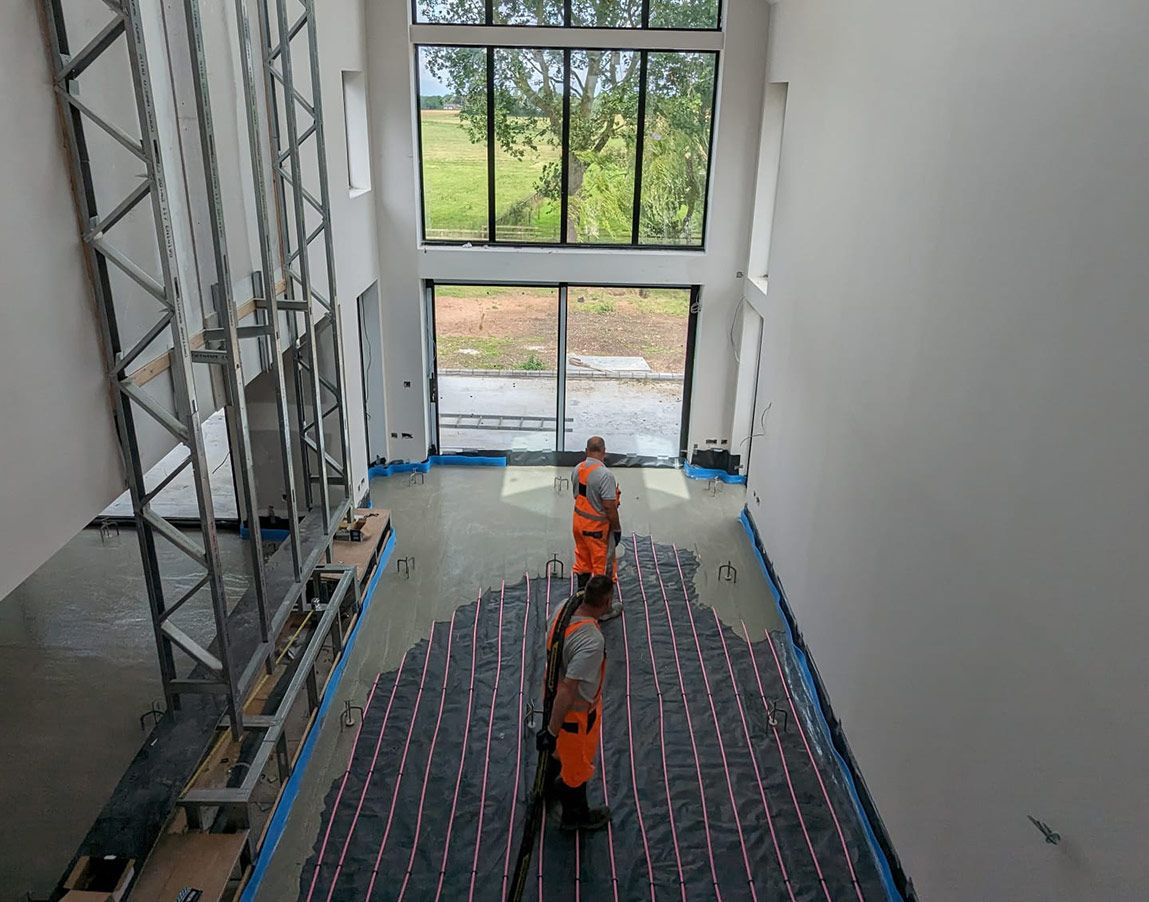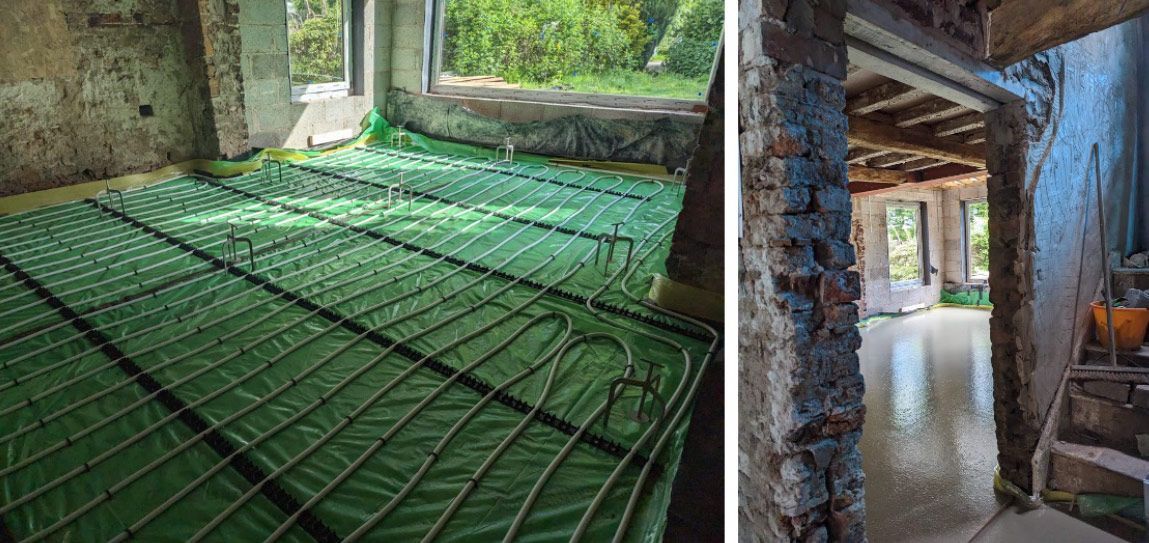Underfloor heating screed
Liquid screed is increasingly being used for flooring within properties where underfloor heating systems have been installed.
Indeed, the performance of underfloor heating isn’t just down to the quality of the system itself. The conditions and floor construction around the system will have a significant impact too. This is where underfloor heating screed offers true value.
Liquid floor screeding effectively conducts the heat from the underfloor heating systems and then evenly distributes it throughout an interior space.
Selecting the right screed type is essential for project success. Read our guide below to understand the key facts in underfloor heating screeds.
To work out how much screed you will need, try our handy screed calculator.

Types of screed for underfloor heating systems
There are three types of liquid screed flooring for use with underfloor heating systems:
1. Traditional Sand and Cement Screed
This type of screed has been used for many years and consists of a mixture of sand, cement, and water, and is applied as a semi-dry mortar.
Traditional screed is known for its strength and durability, making it suitable for high-traffic areas. It can also accommodate various floor finishes. However, it has longer installation and drying times compared to other options, which can delay your project's completion. This type of screed will not encapsulate UFH pipework, leaving air voids which can reduce the efficiency of your underfloor heating system.
2. Anhydrite Screed
Anhydrite screed is a calcium sulphate-based screed that is widely used in properties with underfloor heating systems installed.
It offers good thermal conductivity and, like any liquid screed, can be poured directly over underfloor heating systems.
Anhydrite screed has a faster drying time compared to traditional sand and cement screed but can have limitations in its use. This type of screed creates a ‘laitance’ on the surface which would require sanding prior to any floor finish being installed. Also, gypsum based screeds can’t be used in any areas where contact with water is possible, so they are not recommended for kitchens or bathrooms.

3. Cement based Liquid Screed
Cement based liquid screed (also known as cementitious screed) is the best of both worlds. Boasting the robustness of traditional sand and cement screeds as well as the flowing, liquid properties of anhydrite screeds, this type of screed is a great solution for underfloor heating systems.
It consists of a blend of cement, sand, water and a specialised binder. The screed is poured directly onto the underfloor heating pipes or insulation to pre-set levels and then dappled to create a smooth surface.
One of its significant advantages is its rapid drying time, which allows for quicker project completion. It also provides excellent thermal conductivity, enhancing the efficiency of your underfloor heating system.
Benefits of liquid screed for underfloor heating
Our cementitious screeds here at Clockwork Screed, have been formulated to deliver excellent thermal conductivity, which is useful when installed over underfloor heating systems.
Because the material self-compacts, there is no risk of bubbled or voids around pipework, and because of its strength it can be laid as thin as 25mm, helping to improve the performance and responsiveness of your underfloor heating. The depth it saves can be used to uprate underfloor insulation - further increasing your building’s environmental performance and helping to reduce running costs.
Another benefit of liquid screed is its durability and shrink-resistance. Our cementitious screed can be deployed to form larger slabs with fewer expansion joints.
There is no surface laitance (or dust) after curing and the floor will be compatible with all cement-based adhesives including fast-track systems.
Unlike many other cement-based screeds, the products we use have shrinkage rates of under 0.05%.
Clockwork underfloor heating - underfloor heating systems
Clockwork Screed install liquid screed for underfloor heating systems. Our teams can cover 1000m² a day, bringing much needed efficiencies to flooring projects. Clockwork Screed liquid floor screed can accommodate the installation of floor finishes when moisture levels are at 2.5%CM whereas other screeds require lower moisture levels which can take weeks or months to achieve.
Because Clockwork Screed liquid floor screed self-compacts, the risk of bubbles or voids around underfloor heating pipework is eradicated. Its exceptional strength also allows for it to be laid as thinly as 25mm which improves the performance and responsiveness of the underfloor heating system.
Why choose Clockwork Screed for your underfloor heating screed?
Clockwork Screed are experts in the supply and installation of underfloor heating screed for a range of residential and commercial floor screed projects. We batch-produce the screed on site and pump it directly onto the underfloor heating system.
Underfloor heating screed is ideal for underfloor heating. Its thermal mass and smooth coverage around the system produces comfortable, even temperatures and reduces energy consumption and running costs.
For more information or to obtain a quote for your underfloor heating project, get in touch.
FAQs
What is the shrinkage rate of Clockwork Screed liquid screed for underfloor heating systems?
Our liquid screed has shrinkage rates of under 0.05%.
How much liquid screed can be installed on underfloor heating systems without joints?
When installed on underfloor heating systems, our liquid screed can cover up to 100m² without joints.
How quickly can I walk on liquid screed after it has been installed on an underfloor heating system?
Clockwork Screed fast-drying liquid floor screed can be walked upon within 24 to 48 hours.

Choose Clockwork Screed as your mobile screeding supplier
With over 30 years of experience in the industry, Clockwork Screed is the premier choice for liquid screed for underfloor heating.
Don’t just take our word for it. Join the ranks of satisfied architects, contractors, and homeowners who have chosen Clockwork Screed as their trusted liquid screed installer in Manchester, Cheshire and the surrounding regions.
Experience a seamless service that prioritises your needs, schedule, and specifications.
To get started, talk to our team today on 0161 546 6945, or email us contact@clockworkscreed.co.uk.
For a quote, refer to our contact page
To calculate your requirements and rough costings, use our handy calculator







